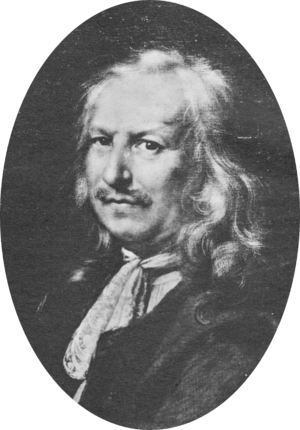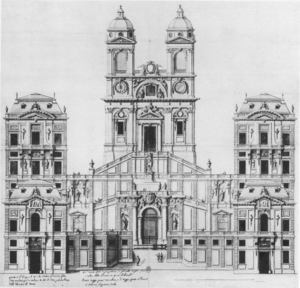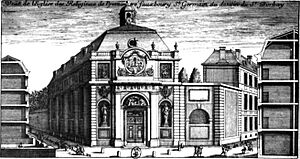François d'Orbay facts for kids
François d'Orbay (born 1634, died 1697) was a talented French architect and draughtsman. He is known for working closely with two very famous architects of his time: Louis Le Vau and Jules Hardouin Mansart. D'Orbay helped design many important buildings in France, including parts of the Louvre and the magnificent Palace of Versailles.
Contents
Becoming an Architect: Early Life and Training
François d'Orbay was born in Paris, France. He probably learned about architecture from his father, who was a master builder. This early training gave him a strong start.
In the late 1650s, d'Orbay became an assistant to Louis Le Vau. Le Vau was a leading architect for the French King. At this time, they were working on the Château de Vincennes, a large royal castle.
In 1660, Le Vau sent d'Orbay to Rome, Italy, to study more about architecture. While in Rome, d'Orbay drew plans for a grand staircase. This staircase was meant for the Trinità dei Monti church. He also designed three buildings next to the church. These designs were never built, but they showed his skill. He likely returned to Paris before the end of 1660.
Designing Churches and Royal Buildings
In 1662, d'Orbay designed the entrance to a church in Paris. This church belonged to the Prémontrés de la Croix-Rouge convent. Anne of Austria, the Queen Mother, asked him to do this work. A friend, the sculptor Étienne Le Hongre, helped with the decorations. He created the royal coat of arms and a sculpture of angels. Sadly, this church was torn down in 1719.
In 1663, d'Orbay got an official job with the King's Buildings department. He mostly worked as a draughtsman, drawing plans for projects. He worked under Le Vau, who was the King's main architect. D'Orbay made many drawings for famous places. These included the Louvre, the Palace of Versailles, and the Collège des Quatre-Nations.
After Le Vau died in 1670, d'Orbay was left in charge of finishing many projects. He sometimes made big changes to Le Vau's original plans.
At Versailles, d'Orbay is thought to have designed the famous Escalier des Ambassadeurs. This was a grand staircase decorated by Charles Le Brun. D'Orbay likely used ideas from an earlier design by Claude Perrault.
In 1671, d'Orbay became a founding member of the Académie Royale d'Architecture. This was a very important group for architects. That same year, he designed the entrance to the Hôpital de la Trinité in Paris. This building was also later destroyed.
Later Career and Independent Projects
Even though he worked for others, d'Orbay also completed some of his own projects later in his career. These include:
- A Carmelite Church in Lyon (built 1680–1682, but later destroyed).
- The Theatre of the Comédie-Française in Paris (built 1688–1689, also later destroyed).
- The Arc de Triomphe du Peyrou in Montpellier (designed in 1690, built by Augustin-Charles d'Aviler).
- Montauban Cathedral (designed in 1692, built from 1692 to 1739). Other architects finished this project after d'Orbay's death.
François d'Orbay died in Paris in 1697.
His Legacy and Recognition
For a long time, François d'Orbay was not very well known. However, in 1960, an architect named Albert Laprade wrote a book about him. Laprade suggested that d'Orbay actually designed many of the most important French buildings from 1660 to 1697. This included the famous Louvre Colonnade and parts of Versailles.
However, many historians later disagreed with Laprade. They pointed out that some drawings used as proof were not by d'Orbay. Also, after Le Vau died, d'Orbay was not chosen to take his place. Instead, Jules Hardouin Mansart became the main architect of Versailles in 1678. D'Orbay then went back to being a draughtsman, working under Mansart. Mansart later became the King's main architect in 1681.
Even with these debates, d'Orbay's work as a draughtsman and his independent projects show his great skill. He played an important role in the grand architecture of 17th-century France.
See also
 In Spanish: François d'Orbay para niños
In Spanish: François d'Orbay para niños





